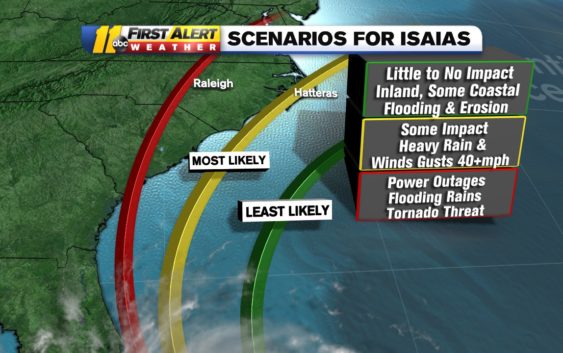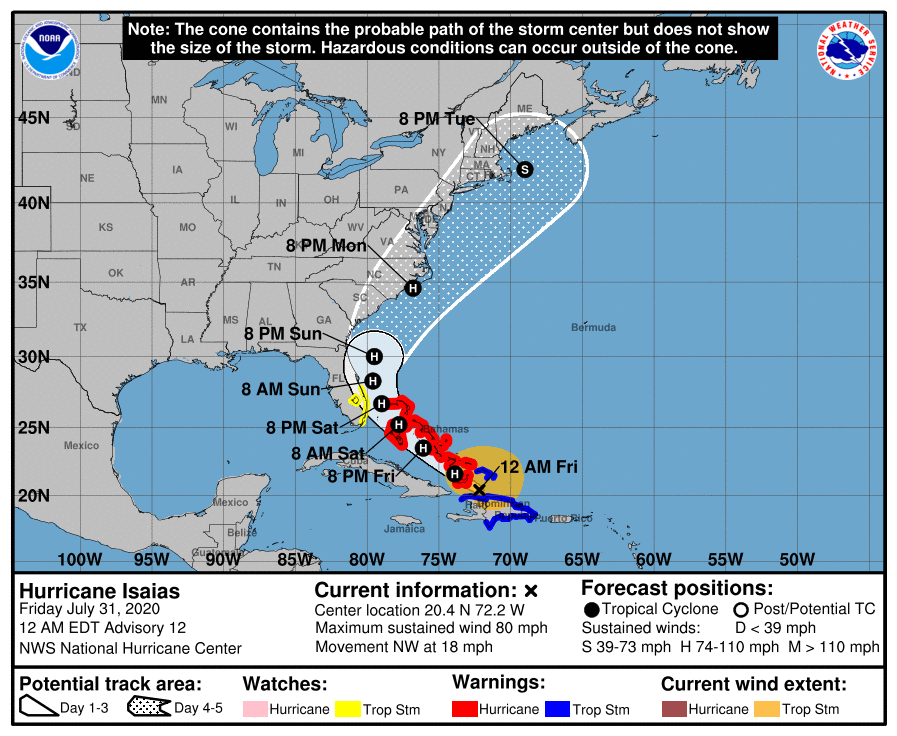- Fake job seekers are flooding the market, thanks to AI
- One set of evacuation orders lifted in Caldwell County after wildfire contained
- 'We gutted every building' | Chimney Rock rebuilding after Hurricane Helene
- 'We gutted every building' | Chimney Rock rebuilding after Hurricane Helene
- Debris from Hurricane Helene provides fuel, complicates containment for spring wildfires
Hurricane Isaias expected to weaken before hitting North Carolina as a tropical storm

As of 5 p.m., the hurricane is moving northwest at 15 mph with maximum sustained winds at 75 mph with gusts reaching up to 90 mph.
Latest reconnaissance aircraft saw signs of an eye wall forming, which is likely the reason the National Hurricane Center predicts the storm will increase to Category Two strength in the next 24 hours–although the system is not expected to remain that strong for long.
The most important question is how far west will the storm go before turning north.
Some models including the Canadian have it coming onshore in south Florida and making its way to the west coast of Florida before turning back to the northeast. The more trusted EURO and GFS make the turn north sooner, keeping Isaias right along the east coast of Florida.
When that turn happens is very difficult to predict and can make all the difference in the world in what affects the storm brings to North Carolina.
If the storm pushes up along the coast of Florida and drives more north that north east, central North Carolina could be in for flooding rain, tornadoes, and widespread power outages. If the storm gets out of the Bermuda High (northwesterly winds around an area of high pressure) and gets pushed by an area of low pressure currently working its way across the central USA, the storm could turn out to sea.
The storm is expected to arrive in North Carolina sometime Monday or Tuesday. The specific timing depends a lot on when Isaias makes its turn north.
All of those scenarios will be better understood in the next 36 hours (by Saturday night/Sunday morning). As soon as the system makes its turn north, the ABC11 First Alert Team will be able to make a much better assessment of the specific impacts Isaias will have in your neighborhood.
Storm Ready 2020: Preparing in a Pandemic
Meanwhile, a mandatory visitor evacuation is in order on Ocracoke Island. Entry to the island is currently restricted to residents, homeowners, vendors, and other essential personnel.
On Friday morning, the storm was spinning around Turks & Caicos and dumping heavy rain on the Bahamas. The National Hurricane Center said flash-flooding and mudslides are possible across the Dominican Republic, northern Haiti, Turks & Caicos and the Bahamas.
On Thursday, more than 400,000 customers in Puerto Rico lost power, according to ABC News. Some were trapped in flooding.
The North Carolina coast is already seeing effects of Isaias as a high risk rip current goes into effect starting Friday stretching from Hatteras down to Carolina Beach. The elevated threat will go on into the weekend as the storm continues to move north.
Colorado State University hurricane researcher Phil Klotzbach said Isaias is the earliest ninth Atlantic named storm. The previous record was Irene on August 7, 2005.

Stay with the ABC11 First Alert Weather team as they monitor this hurricane and any threats it may bring to North Carolina.
WATCH: Big Weather’s hurricane emergency kit
Copyright © 2020 WTVD-TV. All Rights Reserved.